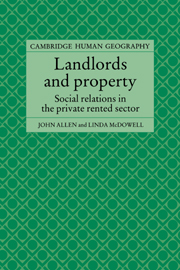Book contents
- Frontmatter
- Contents
- List of figures and tables
- Preface
- 1 Introduction
- 2 Private landlords: the anatomy of uneven decline
- 3 The structure of private landlordism
- 4 Research design and methods
- 5 Landlords in profile: an intensive survey
- 6 Landlords in the inner city: an extensive survey
- 7 Political ideologies and private rental policies
- Policy postscript
- Appendix 1 Selecting the landlord sample from housing waiting list records
- Appendix 2 Who was rehoused?
- References
- Index
2 - Private landlords: the anatomy of uneven decline
Published online by Cambridge University Press: 17 September 2009
- Frontmatter
- Contents
- List of figures and tables
- Preface
- 1 Introduction
- 2 Private landlords: the anatomy of uneven decline
- 3 The structure of private landlordism
- 4 Research design and methods
- 5 Landlords in profile: an intensive survey
- 6 Landlords in the inner city: an extensive survey
- 7 Political ideologies and private rental policies
- Policy postscript
- Appendix 1 Selecting the landlord sample from housing waiting list records
- Appendix 2 Who was rehoused?
- References
- Index
Summary
The declining share of domestic property owned by private landlords has been a well-established feature of the British housing market for many years. Numerous general studies, conventionally relying on analysis by tenure, have documented, in more or less detail, this decline since 1914 (Cullingworth, 1963; Eversley, 1975; Greve, 1965; Nevitt, 1966). A figure of 90 per cent of all households living in privately rented property in 1914 is generally accepted as the basis from which the decline started, dwindling to a minority provision at whatever date the various studies terminate. However, private landlords still, in 1981, housed two million households, or 4.8 million people, a sizeable minority in itself and, in addition held vacant a proportion (2 per cent of all dwellings but 40 per cent of all vacancies in England and Wales in 1977 (Bone and Mason, 1980)) of the housing stock of this country, in anticipation either of reletting or selling. As well as being a sizeable, and highly contentious phenomenon – arguments about the pros and cons of residential letting, size of returns, concentration of housing problems in this sector are legion (Cullingworth, 1972, 1979; Murie et al., 1976; Short, 1982). We argued in the introduction that the dimensions of the decline of private landlords have not yet been adequately revealed, nor have the practices of landlords themselves been fully understood.
- Type
- Chapter
- Information
- Landlords and PropertySocial Relations in the Private Rented Sector, pp. 12 - 39Publisher: Cambridge University PressPrint publication year: 1989



